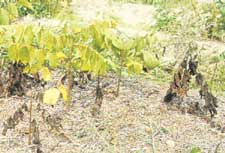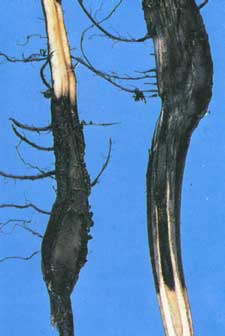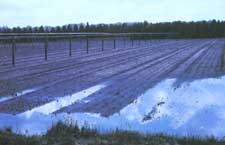Forest Nursery PestsRalph J. Green, Jr. - Plant Pathologist, Department of Botany and Plant Pathology, Purdue University, West Lafayette, IN. Cordell C.E., Anderson R.L., Hoffard W.H., Landis T.D., Smith R.S. Jr., Toko H.V., 1989. Forest Nursery Pests. USDA Forest Service, Agriculture Handbook No. 680, 184 pp. Hosts Seedlings of black walnut are highly susceptible to a root rot disease caused by Phytophthora spp., especially P. cinnamomi, P. cactorum, and P. citricola. Distribution Phytophthora root rot occurs wherever black walnut seedlings are grown. It is especially damaging in the North-Central United States. The disease is limited to nursery seedbeds; it is not recognized as a problem in natural regeneration. Damage Black walnut seedlings may be severely damaged by Phytophthora root rot; often significant mortality occurs in nursery beds. In the Northern States, walnut seedlings are usually lifted in the fall and stored in heeling-in yards or cold storage until spring. The fungi may spread in bundles of dormant seedlings as part of a molding-root rot complex, causing further losses during storage and transit. Seedlings with incipient infection often die following outplanting. Diagnosis Walnut seedlings affected with Phytophthora root rot become chlorotic and wilt rapidly (fig. 34-1). In later stages, the leaves collapse, and the entire seedling turns black. The tissues of infected seedlings are soft, watery, and black, beginning at the root collar and extending through the root and lower stem (fig. 34-2). Infected seedlings usually occur in patches in the seedbed, suggesting that the fungus spreads from plant to plant after infection begins. Root rot is always more severe in low areas of the plant beds, where drainage is poor (fig. 34-3). Infected seedlings are rapidly colonized by secondary organisms, making isolation of the primary pathogen difficult. Use of selective culture media is often required. Identification of individual species of Phytophthora is usually left to specialists in this group of fungi. Biology Phytophthora spp. survive in soil either as dormant chlamydospores, oospores, or both, and require high soil moisture to activate their motile zoospores. They are considered weak pathogens, and infection is usually limited to young seedlings or plants that have been damaged or weakened. Disease incidence is greatest following periods of heavy rains, when surface water may accumulate for periods of 24 to 72 hours or more. Control Cultural - Root rot of black walnut seedlings is always associated with poor surface and internal soil drainage in the nursery. The nursery area used for black walnut should be tiled and well drained. This disease will also develop during winter storage if moisture and temperature conditions are favorable; therefore, the heeling-in beds also should be located in areas with good drainage. Chemical - Although soil fumigation and other chemical treatments of the soil and seed may reduce the impact of this disease, at present there is no completely effective chemical control. The fungicide metalaxyl, applied as a soil drench, will provide some control of Phytophthora root rot on black walnut seedlings in nursery beds. Selected References Green, RJ. 1975. Phytophthora root rot of black walnut seedlings. In: Peterson. Glenn W.; Smith. Richard S., Jr., tech. coords. Forest nursery diseases in the United States. Agric. Handb. 470. Washington. DC: U.S. Department of Agriculture: 19-22. Green. R.J.; Pratt. R.G. 1970. Root rot of black walnut seedlings caused by Phytophthora citricola. Plant Disease Reporter. 54: 583-585. |
Forest Pests: Insects, Diseases & Other Damage Agents |

|
|




